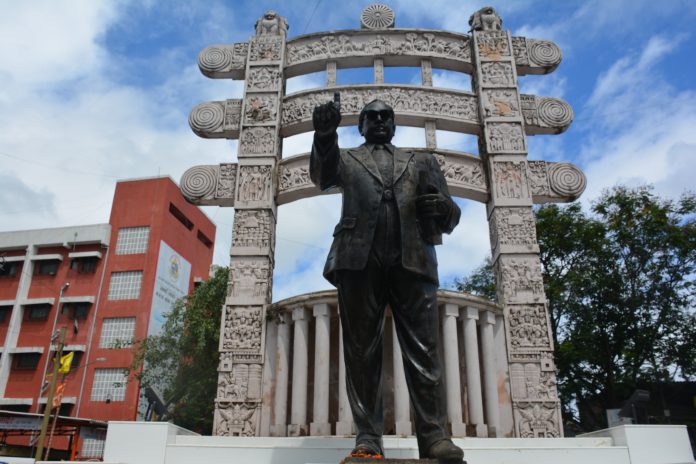By Aparajita Ghosh, TwoCircles.net
Mumbai: “His head was blooming just like a lotus”, recalls Mangesh Shivsharan’s mother, who collected parts of his nine-year-old son’s brain, after he was hit by a bullet fired by police in Mumbai.
As many as 10 Dalits were killed and 26 injured by Special Reserve Police Force (SRPF) led by PSI Manohar Kadam on 11 July 1997 in Ghatkopar’s Ramabai Nagar of Mumbai. The residents had witnessed Dr Babasaheb Ambedkar’s statue garlanded with sandals at dawn on Friday, causing anger among them and this resulted into protests.
The crowd reportedly enforced rasta roko, blocking the Eastern Express Highway and lodged a complaint to the Beat No.5 of Pantnagar Police Station which is situated within Ramabai Nagar. In no time, a total of four vans of SRPF arrived near the statue and began firing into the crowd.
“The distance between the statue and the police force was fifty steps when they opened fire in the alleys of the colony”, said Jaywant Hire, a senior journalist and a social activist from Ramabai Nagar.
“Namdeo Surwade came running to me when he was shot on his arm. He told me that firing was going on inside. I immediately called several ministers and media after seeing the site, and around 12 in the noon, police arrested me from my house”, he added.
Soon ‘Mumbai Bandh’ was declared with shutters pulled down and railway tracks uprooted, bringing trains to halt and traffic being diverted from the nearby areas. The Dalit strongholds of Mumbai witnessed stone-pelting incidents as well.
A twenty-two-year-old Hitesh Bhalerao was killed in a protest against the Ramabai Nagar incident in the eastern suburbs of Kurla when the police opened fire on the crowd.
Raghunath Jadhav was on his way to work and while walking to the bus stop he was shot in his arm, “I was clueless where the bullet came from. A boy came running to me saying your arm is bleeding and I fell unconscious right after.”
The police force lathi-charged and used tear gas to disperse the residents who would take recourse inside the alleys of the colony for cover.
“I was shot just outside my house when I saw police entering the alley and started firing out of nowhere. I first thought it must be the sound of fireworks,” said Hiraman Gaikwad.
The street was spattered with blood and the bullets pierced through tin-roofed homes. The brutal firing continued for nearly fifteen minutes and around fifty rounds of bullets were fired.
“A doctored video was recorded by Ravi Shinde, near the highway with a fabricated LPG tanker story”, said Hire.
Ramchandra Dhanawade, the father of Anil Dhanawade, broke down while narrating the gory details of losing his 18-year-old. “He was shot on his chest when he went to drop his nephew for school,” he said.
In their defence, the police stated that they fired after the crowd set a passenger bus on fire and they (police) were apprehensive that they would set the tankers ablaze too.
“They fired indiscriminately without observing any norms at all. Several bullets had hit above the waists of the victims. This situation was uncalled-for”, said Advocate B. G. Bansode, who represented Ramabai Nagar residents at Gundewar Commission.
Among the victims, Sukhdev Kapadne, Nandu Katare, Sanjay Nikam, Amar Dhanawade, Vilas Dodke, Anil Garud, Sanjay Kamble, Mangesh Shivsharan, Bablu Verma, Kausabai Pathare were killed on spot.
The Maharashtra state government soon appointed The Gundewar Commission, headed by Justice S.D. Gundewar for conducting a detailed investigation of the incident.

The Gundewar Commission submitted the report in both State Legislative Council and Assembly stating ‘there was no need for the SRPF to begin firing and whosoever instigated the incident should discontinue from the police force.”
“The victims who were injured in the incident were blamed as accusers in the sessions court by Manohar Kadam and the inquiry went on for a year”, said Shyam Gaikwad, a senior activist.
‘Hatyakand Virodhi Sangharsh Samiti’ was founded in 1997 by Gaikwad to help the victims of the Ramabai Nagar incident to fight cases and support them with legislative work.
“Both Ramabai residents and Manohar Kadam had their magistrates, while the hearing needed to take place in the same court,” said Advocate Rajesh Karamkar.
“The residents were booked under three cases falling under section 334, 335 and 336 IPC (voluntarily causing grievous hurt on provocation and negligent act on personal safety to be punished with imprisonment) respectively. No one had an idea about it for nearly seven months until we went to the court,” he added.
Previously, convicted under section 304 IPC (culpable homicide with imprisonment) PSI Manohar Kadam was granted bail in the year 2009 when Bombay High Court suspended his life sentence by a vacation bench of Justices Anand Nirgude and Rajesh Ketkar.
“Manohar Kadam was never incarcerated in his entire term of imprisonment. The system was challenged because the government was reluctant to prosecute Kadam”, said Advocate Bansode.
“Government comes and goes, but the leaders stay”, he added.

